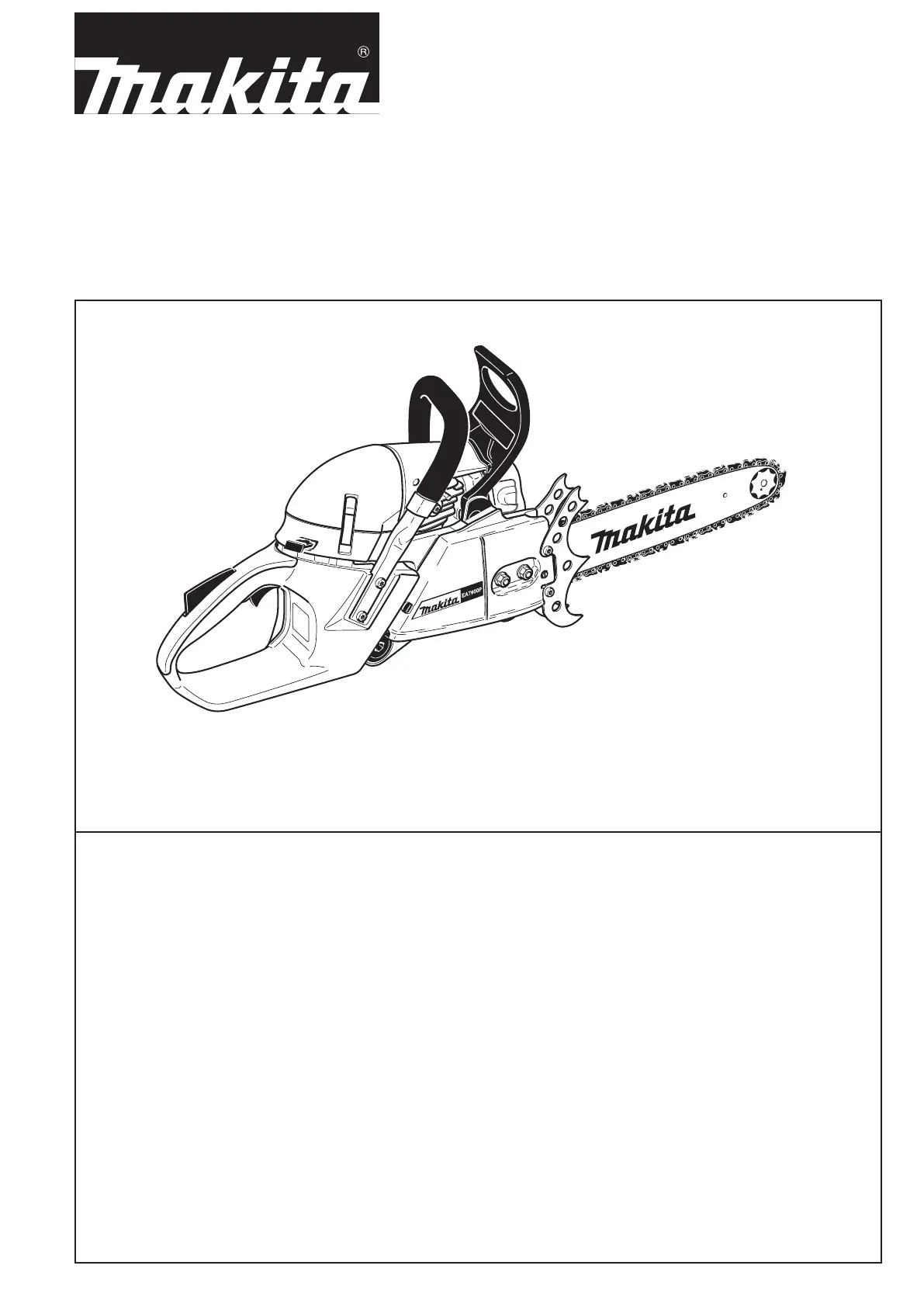Makita EA7900P Bruksanvisning
Läs gratis den bruksanvisning för Makita EA7900P (76 sidor) i kategorin Sågmaskin. Guiden har ansetts hjälpsam av 34 personer och har ett genomsnittsbetyg på 4.5 stjärnor baserat på 17.5 recensioner. Har du en fråga om Makita EA7900P eller vill du ställa frågor till andra användare av produkten? Ställ en fråga
Sida 1/76

1
EA7300P
EA7900P
Operator’s and Safety Manual
for Gasoline Chain Saws (page 2 - 39)
Manuel d’emploi et de sécurité
de tronçonneuses thermiques (page 40 - 77)
WARNING!
Read and understand this Manual. Always follow safety precautions in the Operator’s and Safety Manual. Improper use can cause serious injury! Preserve this Manual carefully!
WARNING!
FUELS WITH MORE THAN 10% ETHANOL ARE NOT APPROVED FOR USE IN MAKITA 2-STROKE ENGINES!
Use of alternative fuels, such as E-20 (20% ethanol), E-85 (85% ethanol) or any fuels not meeting MAKITA requirements are not approved for use in MAKITA 2-stroke gasoline engines!
USE OF ALTERNATIVE FUELS CAN CAUSE THE FOLLOWING PROBLEMS:
Poor engine performance, loss of power, overheating, fuel vapor lock, improper clutch engagement, premature deterioration of fuel lines, premature deterioration of gaskets,
premature deterioration of carburetors.
USING ALTERNATIVE FUELS AND/OR 2-STROKE OILS NOT ACCORDING TO JASO FD OR ISO-L-EGD IN MAKITA 2-STROKE ENGINES WILL VOID YOUR ENGINE WARRANTY!
ATTENTION !
Suivez toujours les conseils de sécurité du présent manuel d’emploi et de sécurité. Une utilisation incorrecte de la tronçonneuse peut entraîner des blessures graves!
Lisez et comprenez ce manuel. Conservez avec soin ce manuel!
ATTENTION !
LES CARBURANTS CONTENANT PLUS DE 10 % D’ÉTHANOL NE SONT PAS AUTORISÉS POUR L’UTILISATION DANS LES MOTEURS 2 TEMPS!
Les carburants alternatifs, tels que E-20 (20 % d‘éthanol), E-85 (85 % d’éthanol) ou tout autre carburant n’étant pas conformes aux exigences MAKITA ne sont pas autorisés
pour l’utilisation dans les moteurs essence à 2 temps MAKITA!
L’UTILISATION DE CARBURANTS ALTERNATIFS PEUT CAUSER LES PROBLÈMES SUIVANTS:
Faible performance moteur, Perte de puissance, Surchauffe, Bouchons de vapeur dans la conduite d’essence, Embrayage incorrect, Détérioration prématurée des conduites
d’essence, Détérioration prématurée des joints d’étanchéité, Détérioration prématurée des carburateurs.
L’UTILISATION DE CARBURANTS ALTERNATIFS ET/OU D’HUILES 2 TEMPS NON-CONFORMES À LA NORME JASO FD OU ISO-L-EGD DANS LES MOTEURS À 2 TEMPS
MAKITA ANNULERA VOTRE GARANTIE MOTEUR!
Produktspecifikationer
| Varumärke: | Makita |
| Kategori: | Sågmaskin |
| Modell: | EA7900P |
| Typ av operation: | Draaiknop |
| Färg på produkten: | Aluminium |
| Inbyggd display: | Ja |
| Timer: | Ja |
| Bredd: | - mm |
| Djup: | - mm |
| Höjd: | - mm |
| Husmaterial: | Aluminium |
| Antal hastigheter: | 8 |
| Tillgångar: | 1500 W |
| Innehåll behållare/burk: | 10 l |
| Varierande hastighet: | Ja |
| Blåtand: | Nee |
| Skålmaterial: | Aluminium |
| Pulsfunktion: | Ja |
| AC-ingångsspänning: | 220–240 V |
| AC-ingångsfrekvens: | 50 - 60 Hz |
| Type beeldscherm: | LCD |
Behöver du hjälp?
Om du behöver hjälp med Makita EA7900P ställ en fråga nedan och andra användare kommer att svara dig
Sågmaskin Makita Manualer

1 April 2025

1 April 2025

1 April 2025

1 April 2025

1 April 2025

1 April 2025

29 Mars 2025

29 Mars 2025

29 Mars 2025

29 Mars 2025
Sågmaskin Manualer
- Cotech
- Donau Elektronik
- MacAllister
- Turbo-Silent
- Hitachi
- MSW
- BabyGO
- MyTool
- Meec Tools
- Backyard Pro
- Ferrex
- Topex
- Sthor
- Graphite
- Duro
Nyaste Sågmaskin Manualer

3 April 2025

3 April 2025

29 Mars 2025

29 Mars 2025

29 Mars 2025

29 Mars 2025

29 Mars 2025

29 Mars 2025

29 Mars 2025

28 Mars 2025